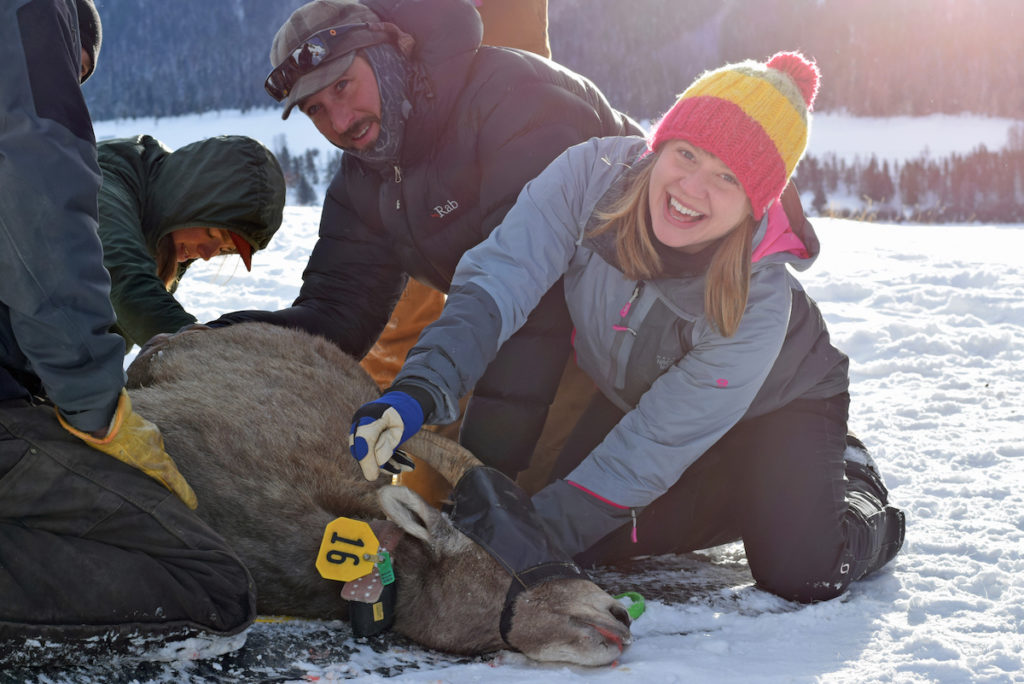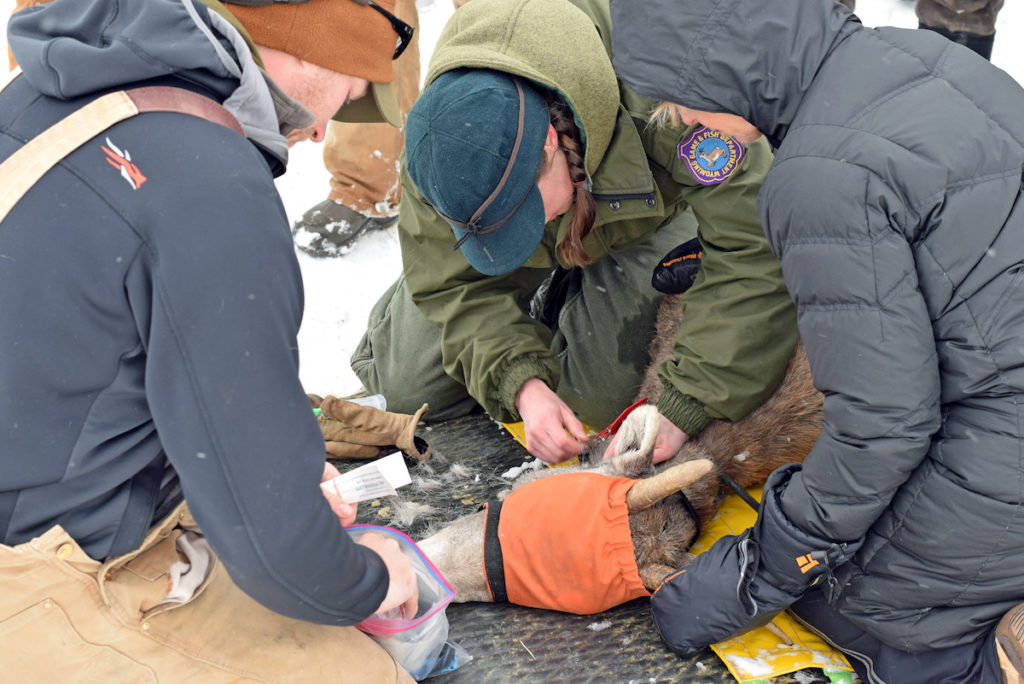By: Aly Courtemanch, Wildlife Biologist, Wyoming Game and Fish Department
You may have noticed some bighorn sheep wearing radio collars or perhaps a helicopter flying low in the Gros Ventre and Curtis Canyon areas earlier this month. For several years, the Wyoming Game and Fish Department (WGFD) has been conducting disease surveillance and monitoring sheep movements and survival in the Jackson Bighorn Sheep Herd. This herd primarily lives in the Gros Ventre Mountain Range. Sheep spend the summer in mountain meadows around Sheep Mountain and deep in the backcountry near the headwaters of Flat Creek, Crystal Creek, Granite Creek, and the Gros Ventre River. Most sheep migrate to lower elevation winter ranges around the Grey Hills, Red Hills, and Lower Slide Lake in the Gros Ventre drainage, foothills in Curtis Canyon and Flat Creek east of the National Elk Refuge, and Miller Butte. The sheep commonly seen along the highway east of Hoback Junction are also part of this herd.

JHWF Associate Director Kate Gersh and Greater Yellowstone Coalition wildlife program coordinator Chris Colligan assist research team. PC: Jon Mobeck
In recent years, the herd has numbered around 400 sheep. However, the herd has undergone two pneumonia die-offs in the past 20 years. In 2001-2002, 50% of the herd died from a pneumonia outbreak. The herd dropped from 500 sheep to approximately 250 sheep. The herd rebounded over the next decade, but underwent another pneumonia outbreak in 2011-2012 when 30% of the herd was lost. Bighorn sheep pneumonia is an extremely complex disease and despite decades of research, its dynamics are still poorly understood. Originally, the disease was transmitted to bighorn sheep populations across the American West in the late 1800s and early 1900s from domestic sheep. Spatial separation of domestic sheep and bighorn sheep is still the primary management strategy to prevent future pneumonia outbreaks. However, we are now learning that contact between domestic sheep and bighorn sheep may not always be needed to instigate a pneumonia outbreak. After a pneumonia outbreak runs its course through a bighorn sheep herd, the sheep that survive are often still infected with the bacterial pathogens. These sheep can harbor these pathogens in their respiratory system for years with no outward symptoms of disease. Then (and this is the unknown part), something will cause these pathogens to suddenly become deadly again and start another die-off throughout the herd. Researchers have tried to link stressors like environmental conditions (such as a severe winter), parasite levels, and density of bighorn sheep (crowding) to pneumonia occurrence, but none have definitively added up. Also, evidence points to multiple bacterial species and within each of those, many strains, potentially playing a role in causing the disease.
Back to the Jackson bighorn sheep herd… Several years of sampling bighorn sheep has shown us that the Jackson Herd currently carries several of the bacterial pathogens that can cause pneumonia. However, the herd has been doing fine since the last outbreak 7 years ago. (This is not unique- most bighorn sheep herds in the Rocky Mountains are infected with some suite of these pathogens.) Over the past three years, the WGFD has partnered with the University of Wyoming to look at this more closely. We are taking a new approach of studying individual bighorn sheep over time and tracking various health metrics: spring and fall body condition (fat levels), pregnancy, lamb survival, parasite levels, blood trace minerals, immune system function, and presence of pneumonia bacterial pathogens. This is the first project of its kind with bighorn sheep, and we are hopeful that it will shed more light on this topic. This is an ongoing project, and you can find more information here: http://wyocoopunit.org/projects/nutritional-dynamics-and-interactions-with-disease-in-bighorn-sheep

Wyoming Game & Fish biologist Aly Courtemanch prepares to withdraw a blood sample. PC: Jon Mobeck
What can you do to help? One early sign that a pneumonia outbreak may be starting in a herd is seeing coughing bighorn sheep. Like humans, bighorn sheep cough periodically for various reasons. However, if you observe one or more bighorn sheep coughing repeatedly (meaning over and over for 30 seconds or more) and severely (meaning they are using their whole body to cough), we would like to know. It is important to record how many sheep you saw coughing, when and where, and their ages and genders if possible (lamb/adult and male/female). Cell phone videos are very helpful too. Also, if you happen to see any dead bighorn sheep, reporting those quickly are very important as well. This will help WGFD be able to monitor when and where a pneumonia outbreak may be starting. For example, several people reported seeing one or two lambs coughing near Miller Butte earlier this winter. As a result, WGFD and National Elk Refuge personnel have been monitoring the sheep on Miller Butte closely to watch for any signs of more sick sheep. Fortunately, we have not observed any more coughing sheep so far. If you observe coughing or dead bighorn sheep, please contact kate@jhwildlife.org or the Wyoming Game and Fish Department at 307-733-2321.
